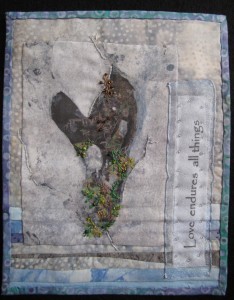During my silent retreat — while I am disconnected from the internet — I have chosen three blogs from the past year to adapt and pre-post. This one is updated from the final Wednesday Reflection in Beltane (late July 2014). It is equally valid as a reflection during the liminal time passing from Lughnasadh into Samhain.
What is your story? The one you tell about yourself?
Who do you think you are? (Seriously.)
How do you describe yourself? Do you use words of love and affirmation, or words of judgment and criticism? Are those words you would use about someone else you loved? (Be honest.)
In psychology, the term ‘perceptual set’ refers to our human tendency to perceive or notice certain things around us and to ignore others based on our learned frame of reference. We do two things (and we usually do them subconsciously, so we aren’t even aware they are going on): we ‘select’ what we see or hear based on our preconceptions or expectations, and we ‘interpret’ what we see or hear based on formative past experience.
Some forms of perceptual set are totally benign (tailors who notice the cut of a suit before they notice the person wearing it; gardeners who notice an unusual plant before they notice the house behind the garden). Some can be useful (a negative childhood experience with a dog may prevent an adult from approaching a similar dog who is in defensive mode – and probably from approaching coyotes and wolves as well).
But we have also seen tragic examples of perceptual set. Following 9/11, a number of Sikhs in this country and abroad were attacked and – in some cases – killed because they were assumed to be Muslims based on the fact that they wear turbans. And, in the perceptual set of the attackers, all Muslims were terrorists who needed to be stopped before they destroyed something else.
Perceptual set is influenced by expectations, motivation, attitudes, culture, and – the big one – emotions.
As I prepare to gather up the lessons of this Lughnasadh and bring their wisdom with me into Samhain (as I did on the threshold between Beltane and Lughnasadh), I remain aware that the stories I tell about myself are part of my perceptual set. If we are predisposed to see what we expect to see and hear what we expect to hear (about ourselves as much as about the world around us), then we need to pay attention to the – seemingly – hard-wired messages we received from early childhood which make us highly susceptible to processing incoming stimuli in specific and, perhaps, unfruitful ways.
If the words I have learned to apply to myself from affirming mentors in the past are generous, loving, intelligent, creative, organized, energetic, principled, and reflective – the sky is the limit. With those empowering words, the world opens up into almost endless horizons and infinite possibilities, virtually nothing is beyond my reach. If, on the other hand, the words from judgmental power figures are spendthrift, gullible, Miss Smartypants, unfocused, inflexible, driven, stubborn, and aloof…it is hard to find energy to try anything at all. No matter what I do, it’s going to be wrong, disappoint those internal (or external) voices, and end badly.
My willingness to explore and experiment, to plant with a risky abandon, nurture with enthusiasm, and offer with open hands is largely dependent on whether I think I can do those things. So, the abundance (or sparseness) of my harvest — my gift to the world — directly correlates to whether I listen with open heart and open ears to the empowering stories or to the demeaning ones. If you ever find yourself listening to the negative tapes running in your head, I invite you to join me in this exercise-reflection.
Pour a cup or glass of your favorite summer beverage and find a comfortable, quiet place away from distractions. Use a beautiful journal or a piece of paper with evocative designs – wrapping paper works or scrapbooking paper or even something plain, but colorful.
Take 15 – 30 minutes to write a list of words or phrases that you (or that voice inside you) apply to yourself. If there is a specific incident attached to any of them, note that briefly.
Close your eyes or turn the paper over and just breathe for a couple of minutes.
Then read what is written aloud and listen carefully to the words and phrases – and to the tone of voice that you associate with them. (Perhaps you hear the word “gullible” with a harsh grating plosive on the “g” that makes you want to look down and scuff your feet.)
Give yourself permission to feel how you respond to these words.
Where you hear a word about yourself that you would never apply to someone you love, find the positive substitute. For instance, I rarely use ‘stubborn’ any more because too often I hear it in my grandmother’s voice preceded by the flick of her eyebrows raising, her head shaking sadly, and my name said with infinite patience. As in, “Andrea [pause, head shake, sad face, shrug], you are so stubborn.” Instead, depending on the situation, I remind myself that I am tenacious (a good quality to have when hanging from the end of a rope over a chasm) or I am principled (good when my employer just asked me to do something illegal) or I am persevering (useful when something needs to be done and absolutely everything that could have gone wrong, has). Perceptual set is not set in stone…and you have the permission of the universe to change yours. Especially the part that applies to you.
Every day when you wake up, read your edited list to yourself. Read it before you go to bed.
Next Tuesday, look at your list of attributes and ask yourself, What you will attempt knowing you have these strengths and qualities of spirit.
And then begin.

And here is a blessing for the week (if you need it or want to use it).
May the Creative One,
the Sustaining One,
the Transforming One
bless you out of “should” and “must”
into the embrace of joyful desire,
into the bounty of prodigal sustenance,
into the grace of abiding delight.
May you be blessed out of word into silence,
out of judgment into appreciation,
out of scarcity into plenty.
May you know blessing.
May you know you are blessing.
–Andrea
Text © 2014, Andrea La Sonde Anastos
Photos © 2011, Immram Chara, LLC
NOTE: The original fiber art piece (Focus: Love) is available for sale in my Etsy shop. Photos of it and the photo of the hands outside the cathedral in Ennis, Ireland are also available as cards or prints from the Etsy shop. The fiber piece can also be seen in the fiber art section of the store here on the website.
